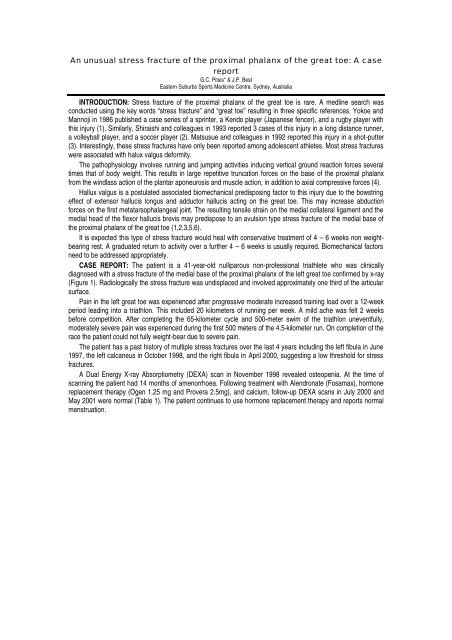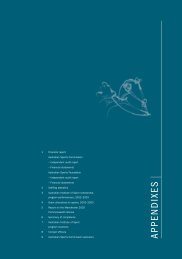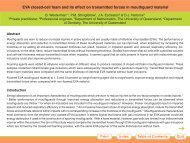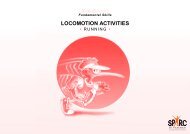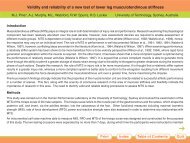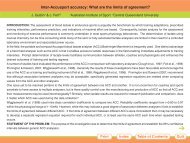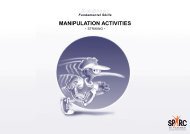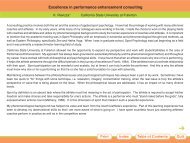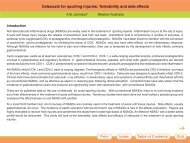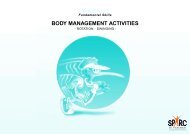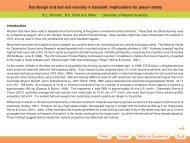An unusual stress fracture of the proximal phalanx of the great toe: A ...
An unusual stress fracture of the proximal phalanx of the great toe: A ...
An unusual stress fracture of the proximal phalanx of the great toe: A ...
You also want an ePaper? Increase the reach of your titles
YUMPU automatically turns print PDFs into web optimized ePapers that Google loves.
<strong>An</strong> <strong>unusual</strong> <strong>stress</strong> <strong>fracture</strong> <strong>of</strong> <strong>the</strong> <strong>proximal</strong> <strong>phalanx</strong> <strong>of</strong> <strong>the</strong> <strong>great</strong> <strong>toe</strong>: A case<br />
report<br />
G.C. Pitsis* & J.P. Best<br />
Eastern Suburbs Sports Medicine Centre, Sydney, Australia<br />
INTRODUCTION: Stress <strong>fracture</strong> <strong>of</strong> <strong>the</strong> <strong>proximal</strong> <strong>phalanx</strong> <strong>of</strong> <strong>the</strong> <strong>great</strong> <strong>toe</strong> is rare. A medline search was<br />
conducted using <strong>the</strong> key words “<strong>stress</strong> <strong>fracture</strong>” and “<strong>great</strong> <strong>toe</strong>” resulting in three specific references. Yokoe and<br />
Mannoji in 1986 published a case series <strong>of</strong> a sprinter, a Kendo player (Japanese fencer), and a rugby player with<br />
this injury (1). Similarly, Shiraishi and colleagues in 1993 reported 3 cases <strong>of</strong> this injury in a long distance runner,<br />
a volleyball player, and a soccer player (2). Matsusue and colleagues in 1992 reported this injury in a shot-putter<br />
(3). Interestingly, <strong>the</strong>se <strong>stress</strong> <strong>fracture</strong>s have only been reported among adolescent athletes. Most <strong>stress</strong> <strong>fracture</strong>s<br />
were associated with halux valgus deformity.<br />
The pathophysiology involves running and jumping activities inducing vertical ground reaction forces several<br />
times that <strong>of</strong> body weight. This results in large repetitive truncation forces on <strong>the</strong> base <strong>of</strong> <strong>the</strong> <strong>proximal</strong> <strong>phalanx</strong><br />
from <strong>the</strong> windlass action <strong>of</strong> <strong>the</strong> plantar aponeurosis and muscle action, in addition to axial compressive forces (4).<br />
Hallux valgus is a postulated associated biomechanical predisposing factor to this injury due to <strong>the</strong> bowstring<br />
effect <strong>of</strong> extensor hallucis longus and adductor hallucis acting on <strong>the</strong> <strong>great</strong> <strong>toe</strong>. This may increase abduction<br />
forces on <strong>the</strong> first metatarsophalangeal joint. The resulting tensile strain on <strong>the</strong> medial collateral ligament and <strong>the</strong><br />
medial head <strong>of</strong> <strong>the</strong> flexor hallucis brevis may predispose to an avulsion type <strong>stress</strong> <strong>fracture</strong> <strong>of</strong> <strong>the</strong> medial base <strong>of</strong><br />
<strong>the</strong> <strong>proximal</strong> <strong>phalanx</strong> <strong>of</strong> <strong>the</strong> <strong>great</strong> <strong>toe</strong> (1,2,3,5,6).<br />
It is expected this type <strong>of</strong> <strong>stress</strong> <strong>fracture</strong> would heal with conservative treatment <strong>of</strong> 4 – 6 weeks non weightbearing<br />
rest. A graduated return to activity over a fur<strong>the</strong>r 4 – 6 weeks is usually required. Biomechanical factors<br />
need to be addressed appropriately.<br />
CASE REPORT: The patient is a 41-year-old nulliparous non-pr<strong>of</strong>essional triathlete who was clinically<br />
diagnosed with a <strong>stress</strong> <strong>fracture</strong> <strong>of</strong> <strong>the</strong> medial base <strong>of</strong> <strong>the</strong> <strong>proximal</strong> <strong>phalanx</strong> <strong>of</strong> <strong>the</strong> left <strong>great</strong> <strong>toe</strong> confirmed by x-ray<br />
(Figure 1). Radiologically <strong>the</strong> <strong>stress</strong> <strong>fracture</strong> was undisplaced and involved approximately one third <strong>of</strong> <strong>the</strong> articular<br />
surface.<br />
Pain in <strong>the</strong> left <strong>great</strong> <strong>toe</strong> was experienced after progressive moderate increased training load over a 12-week<br />
period leading into a triathlon. This included 20 kilometers <strong>of</strong> running per week. A mild ache was felt 2 weeks<br />
before competition. After completing <strong>the</strong> 65-kilometer cycle and 500-meter swim <strong>of</strong> <strong>the</strong> triathlon uneventfully,<br />
moderately severe pain was experienced during <strong>the</strong> first 500 meters <strong>of</strong> <strong>the</strong> 4.5-kilometer run. On completion <strong>of</strong> <strong>the</strong><br />
race <strong>the</strong> patient could not fully weight-bear due to severe pain.<br />
The patient has a past history <strong>of</strong> multiple <strong>stress</strong> <strong>fracture</strong>s over <strong>the</strong> last 4 years including <strong>the</strong> left fibula in June<br />
1997, <strong>the</strong> left calcaneus in October 1998, and <strong>the</strong> right fibula in April 2000, suggesting a low threshold for <strong>stress</strong><br />
<strong>fracture</strong>s.<br />
A Dual Energy X-ray Absorptiometry (DEXA) scan in November 1998 revealed osteopenia. At <strong>the</strong> time <strong>of</strong><br />
scanning <strong>the</strong> patient had 14 months <strong>of</strong> amenorrhoea. Following treatment with Alendronate (Fosamax), hormone<br />
replacement <strong>the</strong>rapy (Ogen 1.25 mg and Provera 2.5mg), and calcium, follow-up DEXA scans in July 2000 and<br />
May 2001 were normal (Table 1). The patient continues to use hormone replacement <strong>the</strong>rapy and reports normal<br />
menstruation.


